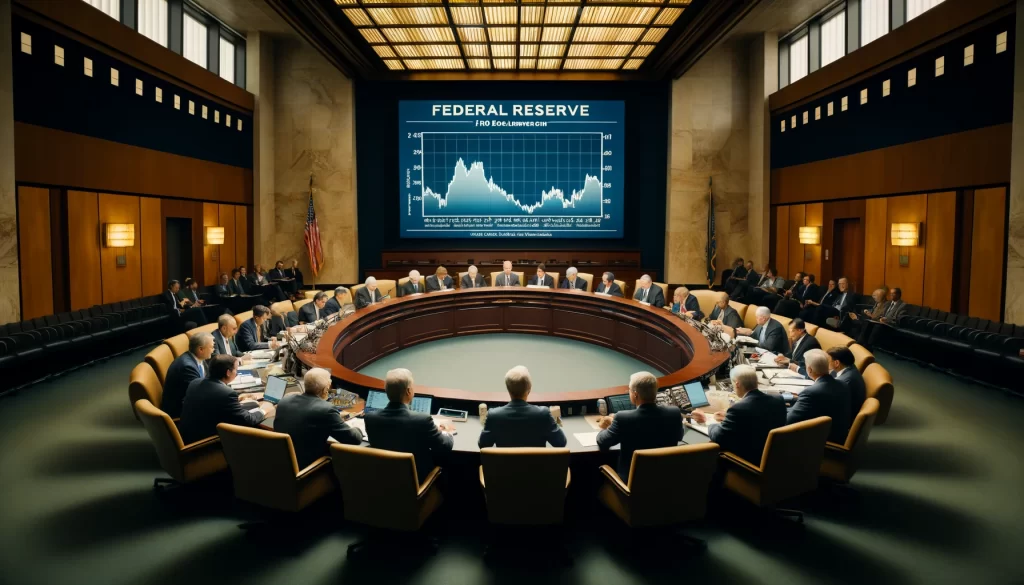The Federal Reserve, which plays a crucial role in managing the United States’ economic stability, monitors various economic indicators to make decisions about interest rates. One of the key indicators they watch is the inflation rate, which measures how prices for goods and services rise over time, affecting purchasing power and cost of living. In March, a significant report showed that inflation is not decreasing as expected, which could lead to higher interest rates for a longer period.
As we entered 2024, many investors were optimistic that the Federal Reserve, often abbreviated as the Fed, would reduce interest rates significantly within the year. This optimism was based on the assumption that inflation would decrease. However, inflation has proven to be more persistent than anticipated, causing a shift in expectations. Many now believe that any reduction in rates will likely be delayed until later in the year, if it happens at all.
The latest data from the Personal Consumption Expenditures (PCE) index, which is a measure of inflation, indicates that the Fed might continue to be cautious about lowering interest rates. From February to March, the overall inflation index increased from 2.5 percent to 2.7 percent annually, which was slightly more than what economists had predicted.
Fed officials pay particular attention to the core PCE index, which excludes food and fuel prices because these can be very volatile. In March, this core inflation rate was 2.8 percent on an annual basis, consistent with the previous month but still higher than what economists expected. This suggests underlying inflation pressures remain, complicating the Fed’s decision-making.
Jerome H. Powell, the Chair of the Federal Reserve, indicated that the progress on reducing inflation has stalled recently. Earlier declines in inflation have not continued into the recent months, leading to uncertainty about when and how much the Fed might reduce borrowing costs.
If inflation continues to stay above the Fed’s target of 2 percent, it may lead the officials to maintain higher interest rates for an extended period. Between March 2022 and the following summer, the Fed increased interest rates to 5.33 percent and has maintained them since, believing these rates are high enough to slow down economic growth, a state referred to as “restrictive” in economic terms.

Despite these high rates, the U.S. economy has shown resilience. Economic growth has been solid, and job creation has been robust, raising questions about how restrictive the current interest rates actually are. Matthew Luzzetti, chief U.S. economist at Deutsche Bank, expressed that there is significant uncertainty about the path to reducing inflation, noting the economy’s continued strength.
Recent data supports this view, with consumer spending increasing by 0.8 percent for two consecutive months, exceeding expectations. This spending boost is supported by a strong labor market that is driving up wages, allowing Americans’ after-tax income in March to surpass the rate of price increases for the first time since December.
On Wall Street, the response was somewhat positive, as the stock indexes rose slightly. This was partly because the inflation report was not as severe as some had feared based on previous data releases. However, the outlook remains cautious, with investors adjusting their expectations towards a longer period of high interest rates, which can negatively impact stock prices.
Market predictions now suggest that the earliest the Fed might lower rates could be in September or later. Some investors even doubt any rate cuts will occur this year. With the economy’s momentum, some economists are considering whether the Fed might need to raise rates again if inflation accelerates.
Fed governor Michelle Bowman has mentioned that it is not her primary expectation, but she acknowledges the possibility that rates might need to be increased further in future meetings. This sentiment is echoed by Luzzetti, who believes a rate hike is possible but would require a significant uptick in the inflation rate.
This article is based on the following article:

Background Information
With this background, readers can better understand why the actions of the Federal Reserve, inflation trends, and interest rates are crucial for economic stability and how they directly impact everyday life, from the cost of groceries to the availability of jobs.
1. What is Inflation?
Inflation refers to the rate at which the general level of prices for goods and services is rising, and subsequently, purchasing power is falling. In simpler terms, when inflation is high, each dollar you own buys a smaller percentage of a good or service than before. Inflation is measured using indices like the Consumer Price Index (CPI) and the Personal Consumption Expenditures (PCE) index. The PCE index is often preferred by the Federal Reserve for its broader range and its ability to adjust more readily to changing spending patterns.
2. The Role of the Federal Reserve (The Fed)
The Federal Reserve is the central bank of the United States and it has several key functions:
- Controlling Inflation: The Fed tries to keep inflation at a target level, which is currently set at 2%. If inflation is too high, the value of money decreases rapidly, and if it’s too low, it could lead to economic stagnation.
- Regulating Banks: The Fed oversees and regulates many of the nation’s banks to ensure the financial system is safe and stable.
- Managing Interest Rates: One of the Fed’s most powerful tools is the manipulation of interest rates. By altering these rates, the Fed can either encourage spending and investment or cool down an overheating economy.
3. Interest Rates and Their Economic Impact
Interest rates influence the economy by affecting consumer and business spending, inflation, and recessions. High interest rates can make borrowing more expensive, slowing down spending and investment, which in turn can reduce inflation. On the other hand, lower interest rates make borrowing cheaper, encouraging spending and investment but potentially leading to higher inflation.
4. Economic Indicators
- GDP (Gross Domestic Product): This is the total value of all goods and services produced over a specific time period and is a broad measure of overall economic activity.
- Unemployment Rate: The percentage of the total workforce that is unemployed and actively seeking employment.
- Consumer Spending: This is the total money spent by people on goods and services, which is a vital driving force in the economy.
5. How the Fed Adjusts Interest Rates
The Fed adjusts interest rates through the Federal Open Market Committee (FOMC) meetings. Decisions are based on various economic data, including inflation rates, unemployment figures, and GDP growth. If the Fed sets high interest rates, it is usually trying to cool down inflation; if it sets low rates, it aims to stimulate economic growth.
6. Recent Economic Trends and Challenges
As noted in the article, the persistence of inflation despite high interest rates poses a challenge for the Fed. Normally, high rates would slow down spending and investment, but the U.S. economy has shown resilience with strong spending and job growth. This situation creates a complex decision-making environment for the Fed as it balances between controlling inflation and not stifling economic growth.

Debate/Essay Questions
- Is the strong performance of the job market in the face of high interest rates indicative of a new economic paradigm?
Please subscribe to Insight Fortnight, our biweekly newsletter!
